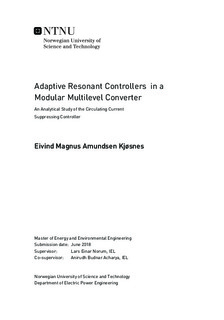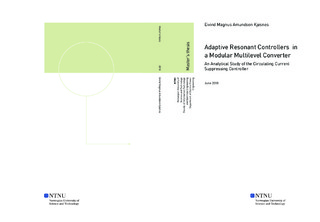| dc.description.abstract | In this thesis work, the modular multilevel converter was investigated. More specifically, an analytical study of circulating current suppression methods for low-bandwidth systems was undertaken. A comparative study of two frequency adaptive digital controllers proposed in earlier research papers has been evaluated to check which yields the most efficient controller.
The modular multilevel converter (MMC) is a converter aimed for high voltage direct current applications. Compared to other voltage source converters, the MMC has several distinct advantages; high efficiency, scalability, modularity, and superior harmonic performance. One of the key advantages is its modular design. The redundancy is proportional to the number of submodules, and having multiple submodules in series gives high redundancy. If one submodule were to fail, the converter could continue to operate with high efficiency by bypassing the failed sub-module.
However, its modular design does also have some drawbacks. First, the more submodules, the higher switching losses. However, the switching losses can be reduced by lowering the switching frequency. By reducing the switching frequency, the system s bandwidth reduces as well. Consequently, the controller s ability to suppress disturbances reduces. Second, a circulating current is introduced to the system. The circulating current is responsible for transferring power from the dc-link to the ac-side, and also balance the energy of the capacitors. If not controlled, the circulating current will be predominant of a second harmonic, which results in higher resistive losses. The additional resistive losses affect the lifetime of semiconductor devices and passive components due to the temperature rise.
To suppress the second harmonic during grid frequency fluctuations, studies of a digital frequency adaptive controller was undertaken. A proportional resonant controller was digitally realised in an infinite impulse response (IIR) filter. By only changing one variable, the filter adapts its resonant peak according to the measured grid frequency. A phase-locked loop was used in combination with a look-up table to measure the grid frequency and to give a new parameter for the IIR filter.
A comparative study of two frequency adaptive digital PR controllers has been undertaken. Both methods are used to change the resonant peak of the IIR filter. The first method proposed in [1] focuses on changing ω0, while the second method proposed in [2] focuses on changing the sampling time. Both controllers were simulated in a system where the grid frequency changed from 50 Hz to 52 Hz, resulting in a 4 Hz jump in the second harmonic. A fast Fourier transform (FFT) analysis reveals that both methods work with high efficiency. However, in medium- and low-bandwidth systems the method proposed in [1] was able to suppress the second harmonic more effectively. | |

